 W
WAl Thompson and Son's Feed and Seed Company, also known as Tobler's Feed and Fuel or Farmers Feed and Seed and currently used as the Oregon Trail Agriculture Museum, is a building located in Nyssa, Oregon in the United States, listed on the National Register of Historic Places.
 W
WAlexander & Baldwin Sugar Museum is located in the small sugarcane growing and milling community of Puʻunene, Hawaii, Kahului, Maui. The museum exhibits the history of Hawaiian sugarcane plantations and Alexander & Baldwin and its role in the sugarcane industry in Hawaii. The company itself continues in business and though it has diversified, it continues to produce sugarcane. The museum itself in the former mill manager's house.
 W
WThe American Royal is a livestock show, horse show, rodeo and barbecue competition held each year in September – November at various sites in the Kansas City Metropolitan Area. The Future Farmers of America was founded during the annual Royal. The Kansas City Royals professional baseball team derive its name from the Royal.
 W
WCalifornia Citrus State Historic Park is an open-air museum in the state park system of California, United States, interpreting the historic cultural landscape of the citrus industry. The park’s museum exhibits and interpretive features share the story of the citrus industry's role in the history and development of Southern California, and is told through the experiences of the diverse migrant and immigrant groups who made it all possible. The California Citrus State Historic Park is in the city of Riverside in Riverside County, California, United States. The 248-acre (100 ha) park was established in 1993.
 W
WCedar Hill State Park is located on FM 1382 and the eastern shore of Joe Pool Lake in Cedar Hill, Texas (USA), ten miles southwest of Dallas. The park was acquired in 1982 and was opened in 1991. The Texas Parks and Wildlife Department operates the 1,826-acre (739 ha) park.
 W
WChippokes Plantation State Park is located at 695 Chippokes Park Road, Surry, Virginia. It is in a rural, agricultural area off the James River and Route 10 in Surry County, and is protected under the state park system.
 W
WThe Orcutt Ranch Horticulture Center, formally known as Rancho Sombra del Roble, is a Los Angeles Historic-Cultural Monument located in the West Hills section of Los Angeles, California, USA.
 W
WCoker Experimental Farms, also known as Coker Pedigreed Seed Company, is a National Historic Landmark agricultural site at 1257 South Fourth Street in Hartsville, South Carolina, USA. Now a museum property, the property was where David R. Coker performed critical breeding experiments to improve strains of cotton and other crops grown throughout the American South. Coker was a major force in the development of agricultural extension services in the South in the early decades of the 20th century. What remains of his farm was declared a National Historic Landmark in 1964.
 W
WCross Orchards Historic Site is a living history museum located in Grand Junction, Colorado. It was added to the National Register of Historic Places in 1980. The Orchards are known for showing how life was on an orchard at the turn of the twentieth century and is considered living history as it is still worked and cultivated regularly. It features a workers' bunkhouse, blacksmith shop, country store, and a collection of vintage farming equipment. The site includes farm equipment, implements and tools, a period farmhouse, a recreated train depot and Uintah Railway exhibit with railroad cars, an engine and caboose, and historic horse-drawn road-building equipment. It is also home to the largest collection of Uintah Railway cars on the Colorado western slope.
 W
WThe Cyrus McCormick Farm and Workshop is on the family farm of inventor Cyrus Hall McCormick known as Walnut Grove. Cyrus Hall McCormick improved and patented the mechanical reaper, which eventually led to the creation of the combine harvester. The farm is near Steele's Tavern and Raphine, close to the northern border of Rockbridge and Augusta counties in the U.S. state of Virginia, and is currently a museum run by the Virginia Agricultural Experimental Station of Virginia Tech. The museum has free admission and covers 5 acres (2.0 ha) of the initial 532-acre (215.3 ha) farm.
 W
WThe Dickinson Museum Center is an organization that preserves and presents history through a museum complex in Dickinson, North Dakota. The organization operates the museum center, which serves as a history museum for the city of Dickinson, Stark County, and Southwest North Dakota.
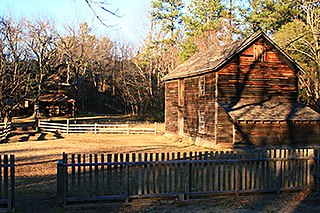 W
WDuke Homestead State Historic Site is a state historic site and National Historic Landmark in Durham, North Carolina. The site belongs to the North Carolina Department of Natural and Cultural resources and commemorates the place where Washington Duke founded the nation's largest early-20th-century tobacco firm, the American Tobacco Company.
 W
WThe Farmers' Museum is located in Cooperstown, New York, and is one of the best-known attractions in the town.
 W
WThe Florida Agricultural Museum is located at Palm Coast in Flagler County, Florida, United States. The museum includes a restored 1890s pioneer homestead, an early 20th century dry goods store, five restored buildings from a 1930s Great Depression-era citrus operation and a 5,000-square-foot dairy barn. The museum also offers opportunity for horseback trail rides. The Florida Agricultural Museum is located at 7900 Old Kings Road.
 W
WThe Fromme-Birney Round Barn near Mullinville, Kansas, United States, is a round barn that was built in 1912. The barn is 50 feet tall and 70 feet in diameter and built with 16 sides to appear round. It was built to house draft horses but the horses were eventually replaced by tractors as the years went on. It was listed on the National Register of Historic Places in 1987.
 W
WThe Fullerton Arboretum is a 26-acre (11 ha) botanical garden with a collection of plants from around the world, located on the northeast corner of the California State University, Fullerton campus in Fullerton, California, in the United States. It is the largest botanical garden in Orange County, with a collection of over 4,000 plants. The Arboretum saves species that are extinct or near extinction and serves as a learning place for agricultural history.
 W
WThe Georgia Museum of Agriculture & Historic Village, formerly known as Agrirama, is a 19th-century living museum located in Tifton, Georgia. It opened on July 4, 1976. The grounds consist of five areas: a traditional farm community of the 1870s, an 1890s progressive farmstead, an industrial sites complex, rural town, national peanut complex, and the Museum of Agriculture Center.
 W
WThe Great Smoky Mountains Heritage Center is a private non-profit museum located in Townsend, Tennessee, United States, near the city's entrance to the Great Smoky Mountains National Park. Its mission is to preserve the heritage and culture of the inhabitants of the Great Smoky Mountains, including both the region's Native American inhabitants and the pioneers and residents of the region's Appalachian communities. The center was organized in the early 2000s, and officially opened in February 2006.
 W
WHallock Homestead is a historic farm complex located at Northville in Suffolk County, New York. The farmstead includes five contributing buildings: the main house, barn, milk house, shop / wood house, and privy. The farmhouse was originally built in 1765 as a one-story, five bay structure with a central chimney. In 1833, a small room was added to the west side and in 1845, the original dwelling was raised to two stories and capped with a broad gable roof.
 W
WThe Indian River Citrus Museum is located at 2140 14th Avenue, Vero Beach, Florida. It houses an exhibit on the citrus industry in Indian River County.
 W
WJefferson Patterson Park & Museum (JPPM) is a 560-acre state park and museum located along the Patuxent River in St. Leonard, Calvert County, Maryland. The property of JPPM was given to the state of Maryland by Mary Marvin Patterson in 1983 in honor of her husband Jefferson Patterson, a U.S. diplomat. Many of its buildings were designed by Gertrude Sawyer starting in the 1930s, and some landscaping was done by Rose Greely and Cary Milholland Parker.
 W
WThe Levi Jordan Plantation is a historical site and building, located on Farm to Market Road 521, 4 miles (6.4 km) southwest of the city of Brazoria, in the U.S. state of Texas. Founded as a forced-labor farm worked by enslaved Black people, it was one of the largest sugar and cotton producing plantations in Texas during the mid-19th century, as well as a local center of human trafficking.
 W
WThe George Key Ranch Historic District, also known simply as Key Ranch, is a historic ranch and Victorian ranch house located in Placentia, Orange County, California
 W
WKona Coffee Living History Farm is located on the Daisaku Uchida Coffee Farm, in the Kona District, on the Big Island of Hawaiʻi. The 5.5-acre (22,000 m2) historic Kona coffee farm was established in 1900.
 W
WThe Kregel Wind Mill Company produced water pumping windmills in Nebraska City, Nebraska starting in 1879. It is now the Kregel Windmill Factory Museum.
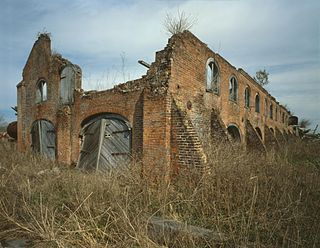 W
WLaurel Valley Sugar Plantation is located in Thibodaux, Louisiana. It is listed on the National Register of Historic Places.
 W
WNorris Dam State Park is a state park in Anderson County and Campbell County, Tennessee, in the southeastern United States. The park is situated along the shores of Norris Lake, an impoundment of the Clinch River created by the completion of Norris Dam in 1936. The park consists of 4,038 acres (16.34 km2) managed by the Tennessee Department of Environment and Conservation. The park also administers the Lenoir Museum Complex, which interprets the area's aboriginal, pioneer, and early 20th-century history.
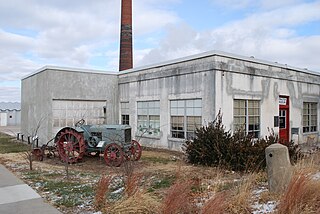 W
WThe Lester F. Larsen Tractor Test and Power Museum is a historical facility located on the East Campus of the University of Nebraska–Lincoln in Lincoln, Nebraska, United States. The museum was established in 1980 and is dedicated to preserving and documenting the history of Nebraska's tractor test law which began as a law to protect others from irresponsible tractor companies failing to keep the best interest of the farmer in mind. Today it remains the only tractor testing museum in the world. It is also still the only complete tractor test laboratory in the world.
 W
WThe Los Altos History Museum (LAHM) is a museum in Los Altos, California. Founded in 2001, the museum showcases the history of Los Altos and surrounding areas, including the transformation of the agricultural paradise once known as the "Valley of Heart's Delight" into the high-tech Silicon Valley. The Los Altos History Museum is situated in one of the few remaining apricot orchards in the San Francisco Bay area.
 W
WThe Mesa Historical Museum is a historical museum in Mesa, Arizona, United States. It was opened in 1987 by the Mesa Historical Society to preserve the history of Mesa, Arizona.
 W
WThe Audie Murphy American Cotton Museum is located at 600 Interstate 30 East, in the city of Greenville, county of Hunt, in the U.S. state of Texas. It was established in 1987. Cotton was Hunt County's largest cash crop in the early 20th century, and the museum features a "History of Cotton" exhibit.
 W
WThe Museum of Appalachia, located in Norris, Tennessee, 20 miles (32 km) north of Knoxville, is a living history museum that interprets the pioneer and early 20th-century period of the Southern Appalachian region of the United States. Recently named an Affiliate of the Smithsonian Institution, the museum is a collection of more than 30 historic buildings rescued from neglect and decay and gathered onto 63 acres (250,000 m2) of picturesque pastures and fields. The museum also preserves and displays thousands of authentic relics, maintains one of the nation's largest folk art collections, and hosts performances of traditional Appalachian music and annual demonstrations by hundreds of regional craftsmen.
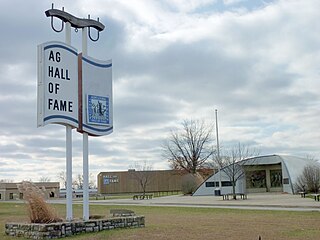 W
WThe National Agricultural Center and Hall of Fame is a museum and educational facility in Bonner Springs, Kansas, United States. The group holds a congressional charter under Title 36 of the United States Code. It is located east of K-7 and south of State Avenue next to the Sandstone Amphitheater and Kansas City Renaissance Festival. It is north of the Kansas Turnpike "Bonner Springs" exit, and about 1 miles west of the Kansas Speedway.
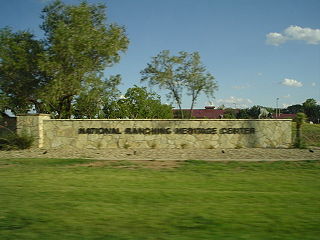 W
WThe National Ranching Heritage Center, a museum of ranching history, is located on the campus of Texas Tech University in Lubbock, Texas. The NRHC features almost fifty authentic ranch buildings dating from the late 18th to the mid-20th century. These structures include a railroad depot, homesteads, barn, blacksmith shop, schoolhouse, windmills and other historic structures. One views the exhibits through a self-guided walking tour. It is free to the public.
 W
WThe New Mexico Farm and Ranch Heritage Museum is a 47-acre (190,000 m2) interactive museum in Las Cruces, New Mexico, that chronicles the state’s 3,000-year history of farming and ranching. The museum is part of the New Mexico Department of Cultural Affairs.
 W
WThe Midwest Old Threshers Reunion is an annual event that takes place in the small town of Mt. Pleasant, Iowa, United States, and runs for five days, ending on the Labor Day weekend. It was first held in 1950, and has taken place every year except 2020, when it was scrapped caused by the COVID-19 pandemic. When first started, it focused on steam engines and antique agricultural equipment, but has developed into an entertainment event with a wider remit. The tiny town of less than 10,000 inhabitants is invaded by many times that number of visitors, drawn from around the world.
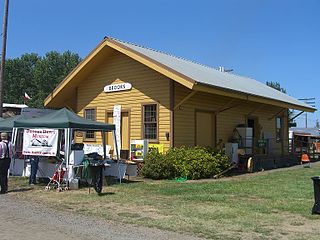 W
WPowerland Heritage Park, formerly known as Antique Powerland, is a collection of museums and a self-described heritage site for power equipment, such as farm machinery, commercial trucks, trains, construction equipment, and the engines which power them. It is located in Brooks, Oregon, United States, and is operated by the non-profit Antique Powerland Museum Association. It was initially established by a group of enthusiasts "dedicated to the preservation, restoration and demonstration of steam powered equipment, antique farm machinery and implements."
 W
WStone Mills Union Church is a historic church at Stone Mills in Jefferson County, New York. It was built in 1837.
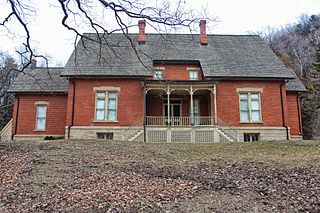 W
WStonefield, located at 12195 County Road VV outside Cassville, Wisconsin, United States, was the 2,000-acre (800-hectare) estate of Wisconsin's first governor, Nelson Dewey. Much of the original estate has been separated into Nelson Dewey State Park and the Stonefield historic site, an expansive museum operated by the Wisconsin Historical Society. The historic site takes advantage of the large property by offering several different areas for visitors, including an early Wisconsin farmhouse, a re-created agricultural village built to resemble those common around 1900, and a reconstruction of Nelson Dewey's home. Stonefield is also home to the Wisconsin State Agricultural Museum, which features a large collection of antique farm equipment.
 W
WWashington-on-the-Brazos is an unincorporated community along the Brazos River in Washington County, Texas, United States. The town is best known for being the site of the Convention of 1836 and the signing of the Texas Declaration of Independence. As of 2009, the estimated population was 265.
 W
WWortendyke Barn, at 13 Pascack Road in Park Ridge, Bergen County, New Jersey, United States, was built in 1770 and added to the National Register of Historic Places on August 2, 1972. The historic Dutch barn was restored by Bergen County in 1973. The barn is home to the Wortendyke Barn Museum. The museum contains an exhibit on the development of agriculture in Bergen County.